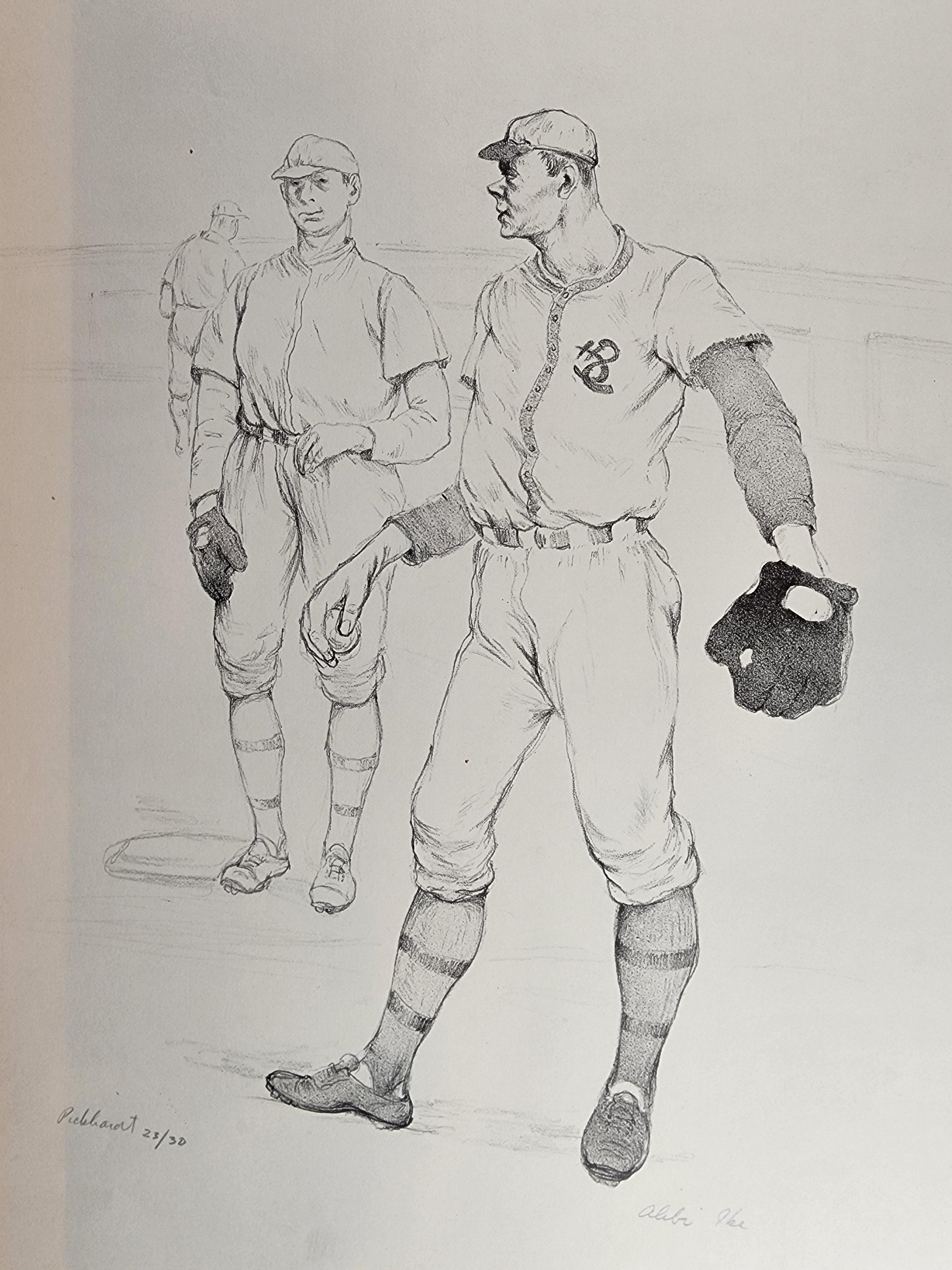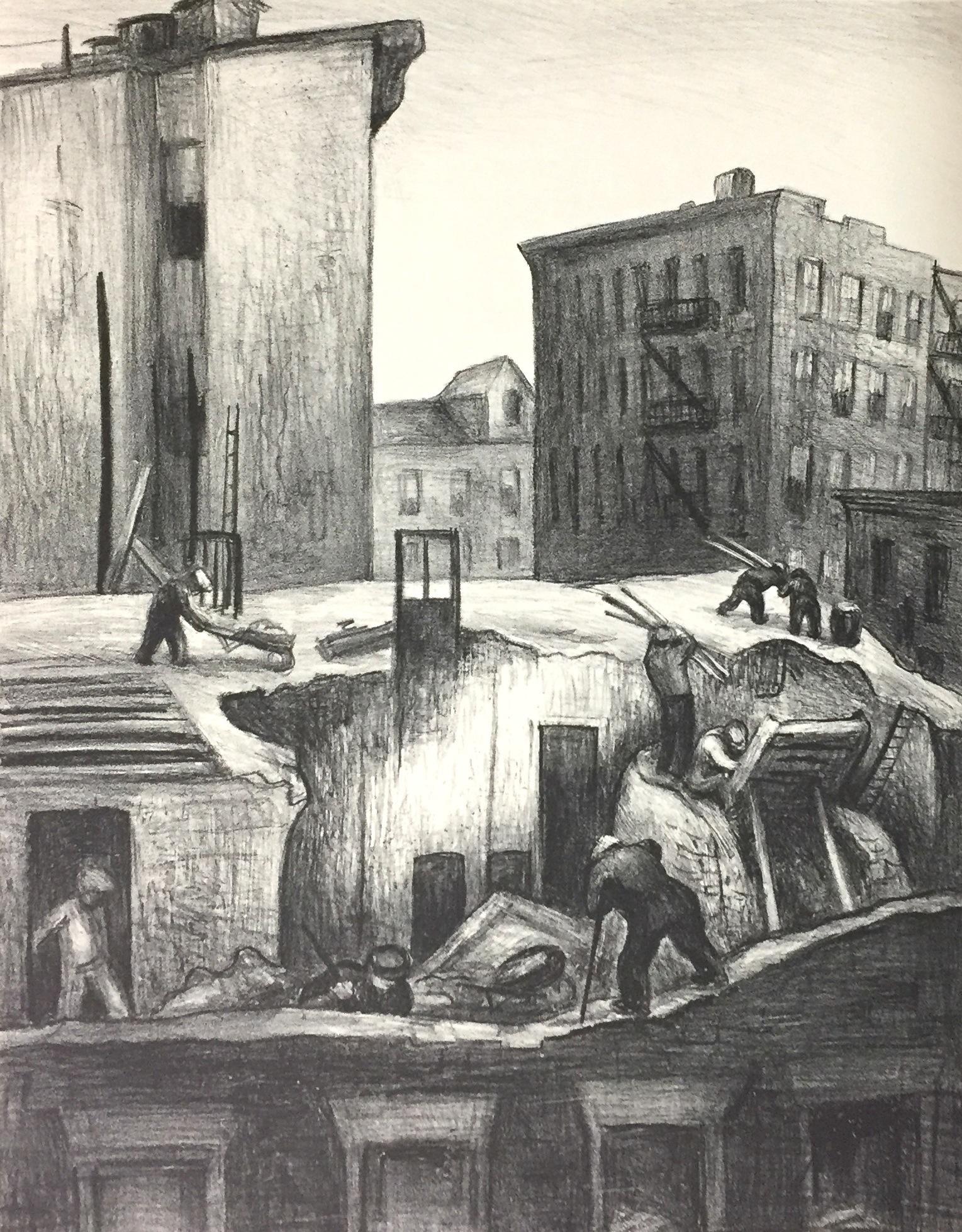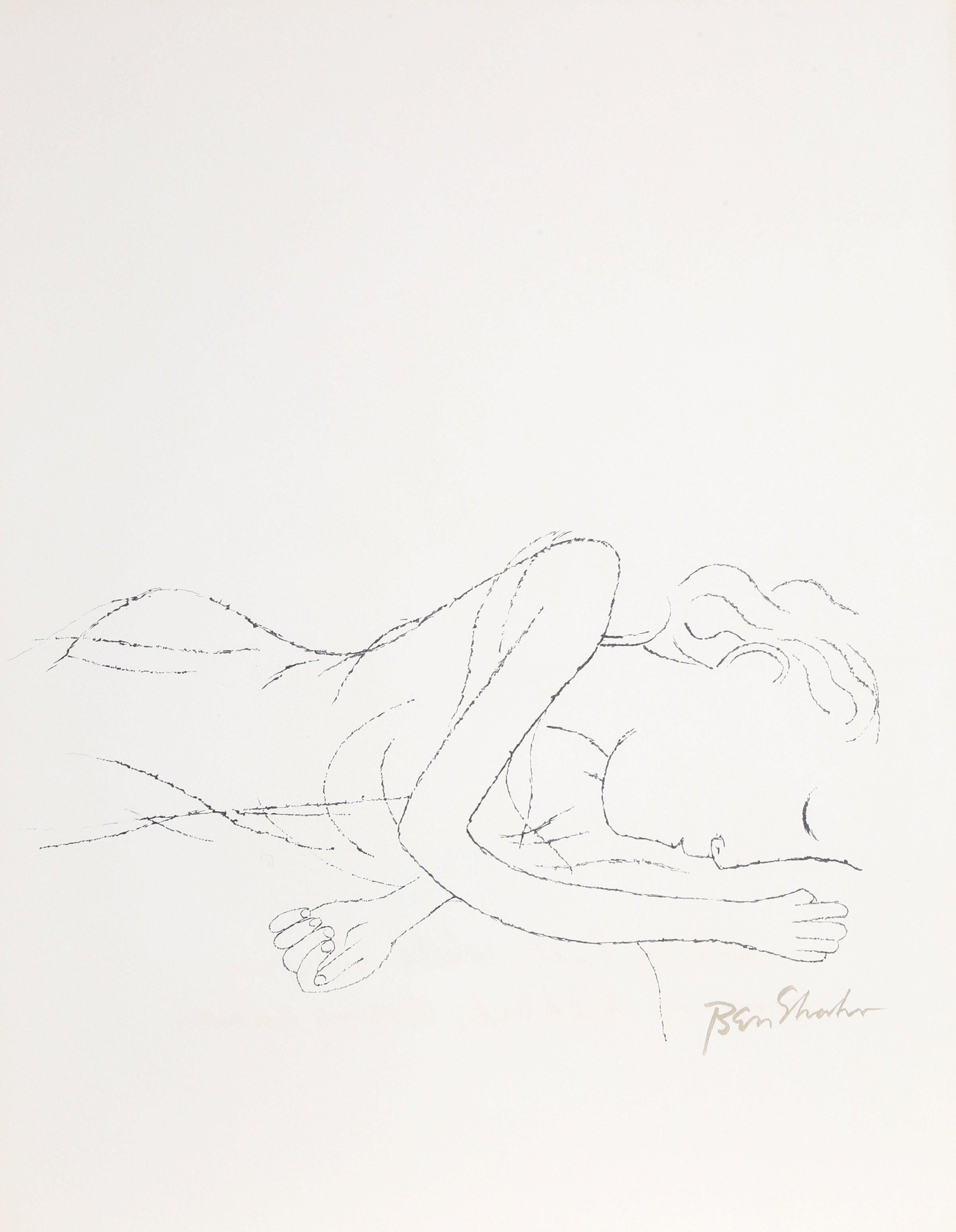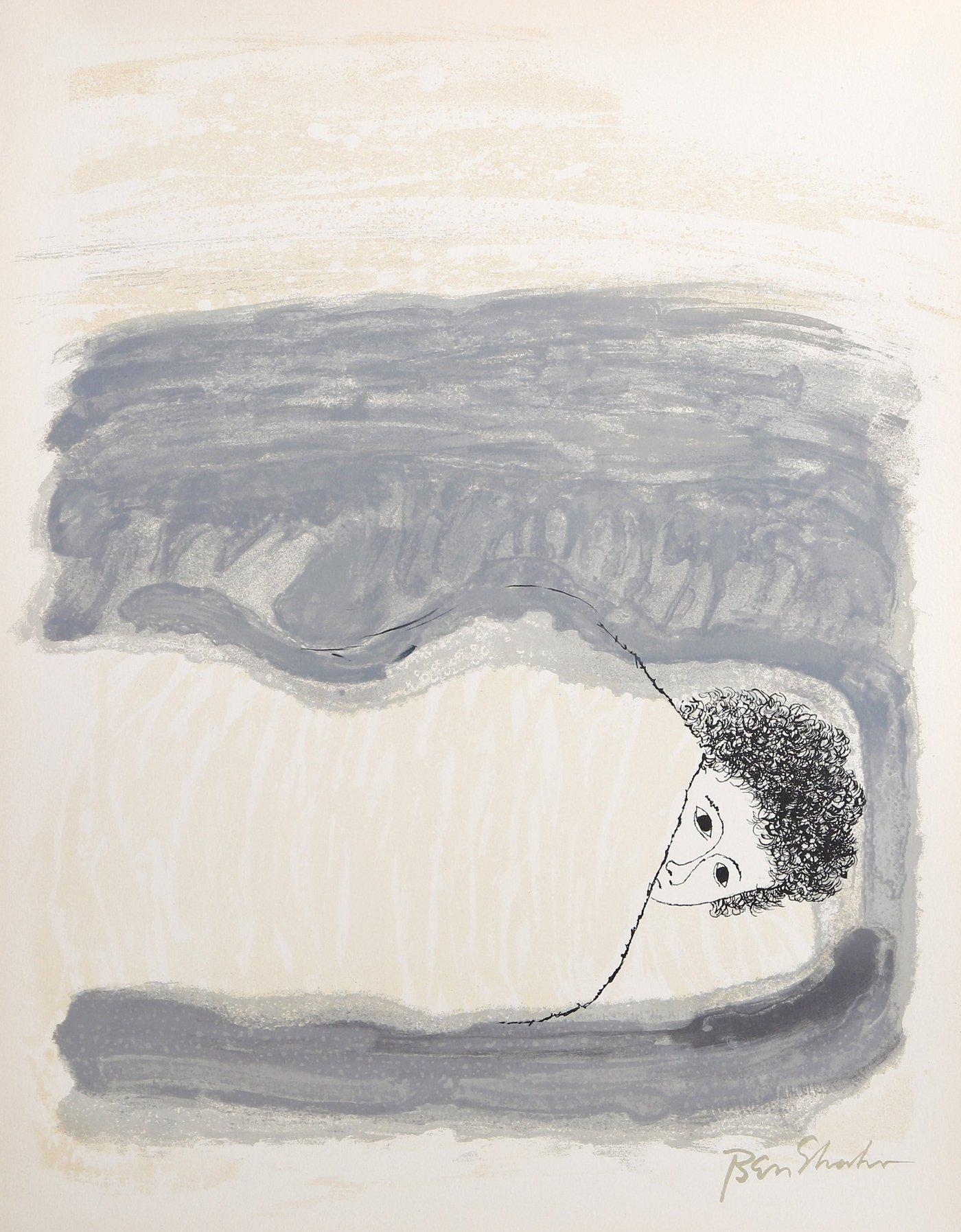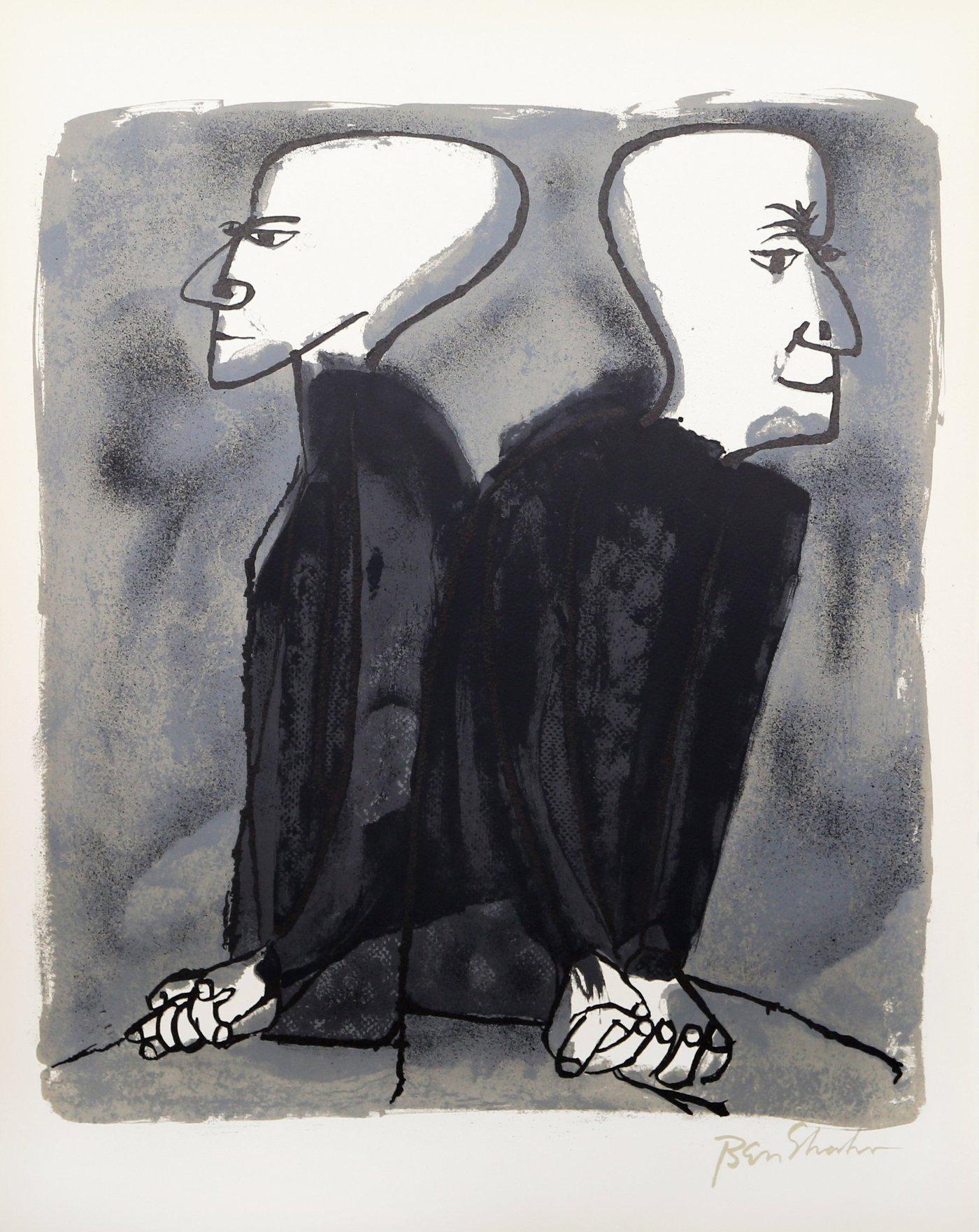Items Similar to Duet — Cellist and Pianist, 1930s Lithograph
Want more images or videos?
Request additional images or videos from the seller
1 of 3
Herschel LevitDuet — Cellist and Pianist, 1930s Lithographc. 1937
c. 1937
About the Item
Herschel Levit 'Duet', lithograph, c. 1937. Signed in pencil. A fine, richly inked impression, on cream wove paper, with full margins (1 1/2 x 2 inches), in excellent condition. Matted to museum standards, unframed.
ABOUT THE ARTIST
Painter, printmaker, photographer, and teacher, Herschel Levit (1912-1986) was born in Pennsylvania. He studied at the Pennsylvania Academy of the Fine Arts and was a member of the Philadelphia Art Alliance, Philadelphia Print Club, and the Modern Etchers Group. Before graduating from the Pennsylvania Academy of Fine Arts, Levit became a Cresson European Fellow and later studied at the Barnes Foundation. In 1947 Alexey Brodovitch, the modern master of design and future ADC Hall of Famer, invited Levit to study at his legendary Design Laboratory. It was soon thereafter that Levit began his teaching career at Pratt Institute with the firm opinion that “the freedom to express oneself through experimentation is the rightful heritage of our artists, for without experimentation there can be no art; there can be no future.”
A true Renaissance man, he believed in a working knowledge of all aesthetic and classical disciplines in order to be a successful designer. “You can’t influence people if you live in a vacuum,” Levit once remarked. His prolific professional design career closely paralleled his teaching career—he created designs and illustrations for album covers, children’s books, and print ads. Levit’s hallmark was his versatility.
Throughout his career, Herschel Levit received recognition for his work in Graphis and various Art Directors Club Annuals. His many exhibitions include the Pennsylvania Academy of Fine Arts, 1934-36; the Art Institute of Chicago, 1934-35, 1938-39; the Philadelphia Arts and Crafts Association, 1938 (one-man); the Philadelphia Art Alliance, 1938, 1944-46; the Springfield Art Museum, 1938; the New School for Social Research, 1938; the Oklahoma Art Club, 1940; the Allied Artists of America, 1945, 1946; the Philadelphia Print Club, 1946; the Library of Congress, 1946; the Pennsylvania Academy of Fine Arts Annual, 1953; and the Pennsylvania Academy of Fine Arts, 1966-69. His drawings and paintings reside in the collections of New York’s Metropolitan Museum of Art, Museum of Modern Art, Museum of Fine Arts, Boston, and The Israel Museum.
As a crowning achievement to his three distinguished decades of teaching at Pratt, the School of Art & Design unanimously named him Professor Emeritus in 1977. A year later, Herschel Levit began teaching advanced photographic techniques at Parsons School of Design, a position he enjoyed up until his death in 1986 at the age of 74.
- Creator:Herschel Levit (1912 - 1986)
- Creation Year:c. 1937
- Dimensions:Height: 11.88 in (30.18 cm)Width: 9.13 in (23.2 cm)
- Medium:
- Movement & Style:
- Period:
- Condition:
- Gallery Location:Myrtle Beach, SC
- Reference Number:
About the Seller
5.0
Recognized Seller
These prestigious sellers are industry leaders and represent the highest echelon for item quality and design.
Platinum Seller
These expertly vetted sellers are 1stDibs' most experienced sellers and are rated highest by our customers.
Established in 1995
1stDibs seller since 2016
254 sales on 1stDibs
Typical response time: 2 hours
Associations
International Fine Print Dealers Association
- ShippingRetrieving quote...Ships From: Myrtle Beach, SC
- Return PolicyA return for this item may be initiated within 7 days of delivery.
More From This SellerView All
- 'Threshing' — 1940s American RegionalismBy Thomas Hart BentonLocated in Myrtle Beach, SCThomas Hart Benton, 'Threshing', lithograph, 1941, edition 250, Fath 48. Signed in pencil. Signed in the stone, lower left. A fine, richly-inked impression, on off-white, wove paper, with full margins (1 3/8 to 1 5/8 inches), in excellent condition. Published by Associated American Artists. Image size 9 5/16 x 13 13/16 inches (237 x 351 mm); sheet size 12 1/2 x 16 5/8 inches (318 x 422 mm). Archivally matted to museum standards, unframed. Impressions of this work are held in the following museum collections: Art Institute of Chicago, Fine Arts Museums of San Francisco, High Museum of Art, McNay Art Museum, Montgomery Museum of Fine Arts, and Nelson-Atkins Museum of Art. ABOUT THE ARTIST “Benton’s idiom was essentially political and rhetorical, the painterly equivalent of the country stump speeches that were a Benton family tradition. The artist vividly recalled accompanying his father, Maecenas E. Benton — a four-term U.S. congressman, on campaigns through rural Missouri. Young Tom Benton grew up with an instinct for constituencies that led him to assess art on the basis of its audience appeal. His own art, after the experiments with abstraction, was high-spirited entertainment designed to catch and hold an audience with a political message neatly bracketed between humor and local color.” —Elizabeth Broun “Thomas Hart Benton: A Politician in Art,” Smithsonian Studies in American Art, Spring 1987, p. 61 Born in 1889 in Neosho, Missouri, Benton spent much of his childhood and adolescence in Washington, D.C., where his lawyer father, Maecenas Eason Benton, served as a Democratic member of Congress from 1897 to 1905. Hoping to groom him for a political career, Benton’s father sent him to Western Military Academy. After nearly two years at the academy, Benton convinced his mother to support him through two years at the Art Institute of Chicago, followed by two more years at the Academie Julian in Paris. Benton returned to America in 1912 and moved to New York to pursue his artistic career. One of his first jobs was painting sets for silent movies, which were being produced in Fort Lee, New Jersey. Benton credits this experience with giving him the skills he needed to make his large-scale murals. When World War I broke out, Benton joined the Navy. Stationed in Norfolk, Virginia, he was assigned to create drawings of the camouflaged ships arriving at Norfolk Naval Station. The renderings were used to identify vessels should they be lost in battle. Benton credited being a ‘camofleur’ as having a profound impact on his career. “When I came out of the Navy after the First World War,” he said, “I made up my mind that I wasn’t going to be just a studio painter, a pattern maker in the fashion then dominating the art world–as it still does. I began to think of returning to the painting of subjects, subjects with meanings, which people, in general, might be interested in.” While developing his ‘regionalist’ vision, Benton also taught art, first at a city-supported school and then at The Art Students League (1926–1935). One of his students was a young Jackson Pollock, who looked upon Benton as a mentor and a father figure. In 1930, Benton was commissioned to paint a mural for the New School for Social Research. The ‘America Today’ mural, now on permanent exhibit at the Metropolitan Museum of Art, was followed by many more commissions as Benton’s work gained acclaim. The Regionalist Movement gained popularity during the Great Depression of the 1930s. Painters, including Benton, Grant Wood, and John Steuart Curry, rejected modernist European influences preferring to depict realistic images of small-town and rural life—reassuring images of the American heartland during a period of upheaval. Time Magazine called Benton 'the most virile of U.S. painters of the U.S. Scene,' featuring his self-portrait on the cover of a 1934 issue that included a story about 'The Birth of Regionalism.' In 1935, Benton left New York and moved back to Missouri, where he taught at the Kansas City Art Institute. Benton’s outspoken criticism of modern art, art critics, and political views alienated him from many influencers in political and art scenes. While remaining true to his beliefs, Benton continued to create murals, paintings, and prints of some of the most enduring images of American life. The dramatic and engaging qualities of Benton’s paintings and murals attracted the attention of Hollywood producers. He was hired to create illustrations and posters for films, including his famous lithographs for the film adaptation of John Steinbeck’s ‘Grapes of Wrath’ produced by Twentieth Century Fox. Benton’s work can be found at the Art Institute of Chicago, High Museum of Art, Fine Arts Museums of San Francisco, Library of Congress, McNay Art Museum, Metropolitan Museum of Art, Minneapolis Institute of Arts, Montgomery Museum of Fine Arts, National Gallery of Art, Nelson-Atkins Museum of Art, Smithsonian American Art Museum, Whitney Museum of American Art, The Truman Library and many other museums and galleries across the US. He was elected to the National Academy of Design, has illustrated many books, authored his autobiography, and is the subject of ‘Thomas Hart Benton,’ a documentary by Ken Burns.Category
1940s American Realist Figurative Prints
MaterialsLithograph
- 'Negro' — California WPA, 1930s Social Realism – African American SubjectLocated in Myrtle Beach, SCNicholas Panesis, 'Negro', 1934, color lithograph, edition 18. Signed, dated, titled, and numbered 8/28 in pencil. Initialed in the stone, lower right. A fine impression, with fresh colors, on buff wove paper, with margins (1 1/8 to 2 3/8 inches). Minor glue staining at the extreme sheet edges verso, where previously taped (not visible recto), otherwise in excellent condition. Matted to museum standards, unframed. Image size 10 5/8 x 8 1/2 inches; (270 x 216 mm); sheet size 14 13/16 x 10 15/16 inches (376 x 278 mm). Created for the California Works Progress Administration, Federal Art Project (WPA). Scarce. Impressions of this work are held in the public collections of La Salle University Art Museum (Philadelphia), U.S. General Services Administration, and Weisman Art Museum (University of Minnesota). ABOUT THE ARTIST Born in Massachusetts, Nicholas Panesis (1913-1967) studied art at Syracuse University, NY, and went on to teach ceramics at Alfred University, NY. Panesis moved to San Francisco in the early 1930s shortly before settling in Los Angeles, where he worked for different animation studios...Category
1930s American Realist Figurative Prints
MaterialsLithograph
- Old InjunBy Charles Banks WilsonLocated in Myrtle Beach, SCCharles Banks Wilson, 'Old Injun', lithograph, 1948, edition 250, Hunt 39. Signed in pencil. A fine, richly-inked impression, on off-white wove paper, with full margins (1 3/4 to 2 inches), in excellent condition. Published by Associated American Artists. Impressions of this work are in the permanent collections of the following institutions: Ackland Art Museum, Georgetown University...Category
1940s American Realist Figurative Prints
MaterialsLithograph
- Ninth InningLocated in Myrtle Beach, SCSylvia Mayzer Rantz, 'Ninth Inning', lithograph, 1949, edition 24. Signed, dated, titled, and numbered '9/24' in pencil. A fine, richly-inked impression, on cream wove paper. The ful...Category
1940s American Realist Figurative Prints
MaterialsLithograph
- Racamadour (French Church Series #10)By John Taylor ArmsLocated in Myrtle Beach, SC'Rocamadour' (French Church Series # 10), etching, 1927, edition 50, Fletcher 186. Signed, dated, and annotated 'First State' in pencil. Titled and dated 'Rocamadour 1926' in the plate, bottom right. A superb, finely detailed impression, in dark brown ink, on buff laid Japan paper, with full margins (1 to 1 7/8 inches), in excellent condition. Image size 13 3/4 x 10 inches (349 x 254 mm); sheet size 15 3/4 x 13 5/8 inches (400 x 346 mm). Matted to museum standards, unframed. Literature: illustrated in Dorothy Noyes Arms, 'Churches of France', The Macmillan Company, 1929. Impressions of this work are in the permanent collections of the Blanton Museum of Art, Chrysler Museum of Art, Cleveland Museum of Art, Davis Museum (Wellesley), McNay Art Museum, Metropolitan Museum of Art, Rhode Island School of Design Museum, and the Whitney Museum of Art. ABOUT THE SUBJECT Rocamadour is a small clifftop village in south-central France. It is known for the Cité Réligieuse complex of religious buildings, accessed via the Grand Escalier staircase. It includes the Chapelle Notre-Dame, with its Black Madonna statue, and the Romanesque-Gothic Basilica of St-Sauveur. ABOUT THE ARTIST “John Taylor Arms will live on and on and future generations centuries from now will marvel at his work... . As a friend and as a man, he fully matched his superb work.” —John Winkler, printmaker Born in Washington, D.C. in 1887, John Taylor Arms attended the Lawrenceville School and began the study of law at Princeton University. In 1907, he transferred to the Massachusetts Institute of Technology and took up the study of architecture. Arms evolved his unique drafting style, with its highly realistic, precise detail and exquisitely rendered effects of light, from his experience and practice as an architectural student. He graduated in 1911 and completed a master’s degree the following year. He then worked as a draftsman with the well-known Carrere and Hastings Company in New York. In 1913 Arms was given a hobbyist’s etching set, and he began to dabble with copperplate and acid. In 1915, after copying a handful of prints by Jongkind and other Etching Revivalists, Arms created his first original etching. His early experiments were picturesque views of European villages, reflecting the influence of Whistler. He inked and printed several of these plates in color in the manner of Charles Mielatz...Category
1920s American Realist Figurative Prints
MaterialsEtching
- Mosque of the Sultan Bayazid, ConstantinopleBy Louis Conrad RosenbergLocated in Myrtle Beach, SCLouis Conrad Rosenberg, 'Mosque of the Sultan Bayazid, Constantinople', etching, 1927. Signed in pencil. Initialed and dated in the plate, lower left. A fine, richly-inked impression...Category
1920s American Realist Figurative Prints
MaterialsDrypoint
You May Also Like
- Alibi IkeLocated in Raleigh, NCRGRFINEARTS is pleased to offer this baseball themed lithograph of Alibi Ike after the character in the 1935 movie. A fine example of the draftsmanship that Pickhardt was known for.Category
1930s American Realist Figurative Prints
MaterialsLithograph
- Ann Nooney, (Demolition with Windows, NYC)By Ann NooneyLocated in New York, NYThe dimensions are for the image; there are large margins. This lithograph is signed in pencil. A native New Yorker, Ann Nooney (1900-1970) recorded the urban scene while on the Wo...Category
1930s American Realist Figurative Prints
MaterialsLithograph
- ReflectionsBy Will BarnetLocated in Buffalo, NY“Reflection, 1971” Medium: Color serigraph Signed and titled Ed: 121/225 Sheet: 30 x 23 in. Image: 22 x 14.5 in. Condition: ExcellentCategory
1970s American Realist Figurative Prints
MaterialsArchival Paper, Lithograph
- Of Light, White Sleeping Women in Childbed from the Rilke PortfolioBy Ben ShahnLocated in Mount Vernon, NYThe Rilke Portfolio by Ben Shahn contained 24 prints from the Atelier Mourlot in New York. The Munn Collection offers 7 unframed lithographs from the o...Category
1960s American Realist Portrait Prints
MaterialsLithograph
- To Childhood Illnesses from the Rilke PortfolioBy Ben ShahnLocated in Mount Vernon, NYThe Rilke Portfolio by Ben Shahn contained 24 prints from the Atelier Mourlot in New York. The Munn Collection offers 7 unframed lithographs from the o...Category
1960s American Realist Portrait Prints
MaterialsLithograph
- Partings Long Seen Coming from the Rilke PortfolioBy Ben ShahnLocated in Mount Vernon, NYThe Rilke Portfolio by Ben Shahn contained 24 prints from the Atelier Mourlot in New York. The Munn Collection offers 7 unframed lithographs from the o...Category
1960s American Realist Portrait Prints
MaterialsLithograph
Recently Viewed
View AllMore Ways To Browse
Craft Association
1930s Childrens
1930s Arts Crafts
Black And Cream Modern Art
Philadelphia Arts And Crafts
Barnes Foundation
Modern Vintage Ads
Oklahoma Sooners Vintage
Herschel Levit
Vintage Teaching Poster
Womens Dior Dress
George I Japanned
Matisse 1948
Henri Stone
Collection Mickey
Retro Cartoon Pop Art
Tete De Tete
Vintage Feminist
